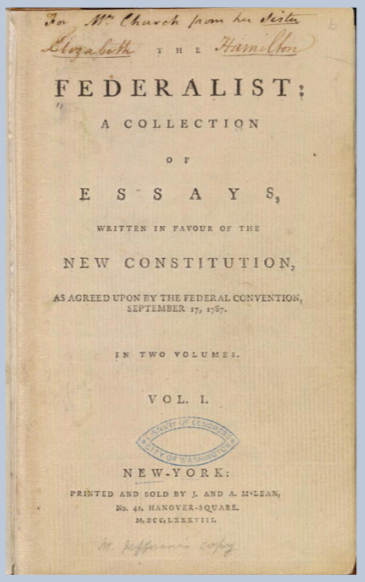3.9: The Federalist (1788)
- Page ID
- 57451
Upon securing their independence from Britain, the American colonies drew up the Articles of Confederation (1777) which stated their “firm league of friendship,” a friendship uniting each colony to the rest but maintaining each state’s separate sovereignty. Determining the need for a central authority to deal with their united problems, a Federal Convention met in Philadelphia in 1787 to draw up a new Constitution, one that delineated the powers of this centralized government. Those who supported such a government became known as Federalists.

Image \(\PageIndex{1}\): The Federalist
Anti-federalists included statesrights advocates, those who perceived a bias in favor of cities over country, and those who feared the authority of a large government. To defend against its critics and encourage its adoption by each state, Alexander Hamilton (1757–1804) began to write a series of essays defending this new Constitution, describing the political theory on which it was founded. Hamilton was a New York lawyer who served as George Washington’s secretary and aide-de-camp during the Revolution; a member of the Continental Congress; a delegate to the Constitutional Convention; and first secretary of the United States treasury. He was joined in this writing endeavor by James Madison (1751–1836), who represented the state of Virginia at both the Continental Congress and the Constitutional Convention and who later became the fourth president of the United States. John Jay (1745–1829), the third author, had been president of the Continental Congress and secretary of foreign affairs and would become the first chief justice of the United States. The three wrote under the pseudonym “Publius,” publishing in New York newspapers a total of eighty-five essays between October 1787 and April 1788.
Although they were published anonymously, their authors became known; it is now the general belief that Hamilton wrote fifty-one essays. In 1788, the collected essays were published as The Federalist. Their influence led to the Constitution’s ratification that same year. Their influence continues well beyond that year to this very day, in the definition they gave to this new government that secured individual rights, protected public good, and mitigated the potential dangers of majority rule.

